This was published 1 year ago
Donatella Versace on her struggles with fame: ‘For years, I wanted to be invisible’
“If people like me now it’s just because I’ve been around such a long time.”
By Lisa Armstrong
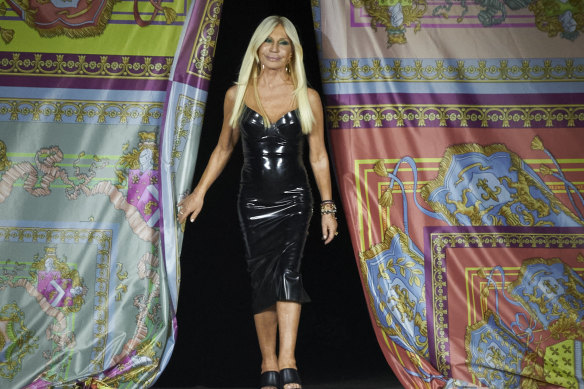
Donatella Versace at the Versace SS22 Fashion Show.Credit: Snapper Images
On the sunny morning we meet in her penthouse offices on the 10th floor of the shiny new Versace HQ in Milan, Donatella Versace is giving it the full works. Superficially, at least.
On closer acquaintance, however, there are subtle signs she’s moved on from the cartoon Donatella who was such a tabloid staple. The hair is still a knowingly unnatural shade of platinum, but it’s shoulder rather than waist length. The diamond slabs that used to adorn her knuckles have been replaced by some kind of “spiritual” Chinese bracelet (truth be told, she’s bored with it but can’t get it off). The tan is more Biedermeier oak than mid-century teak and the tight, tight black clothes of yore have been replaced by a twinset and pearls.
Actually, that last bit isn’t true. The black trousers are still tight, though flared from the knee. On top, she’s wearing a floaty purple chiffon blouse. On her feet – it would be disappointing if otherwise – five-inch heels. This is Donatella at 68: thoughtful, self-deprecating, but giving no quarter to the Grow Old Gracefully lobby.
What must it be like to be the very public face of a brand that’s always set a premium on an explicitly youthful sexiness? The answer’s not simple. While she was always shy, Donatella didn’t exactly shun the limelight – unlike her daughter Allegra, now 36, who works for the company strictly behind the scenes. But in the early noughties, with celebrity magazines prowling for humiliating pictures of celebrities, Donatella was hunted.
Her response? To get more tanned, more tweaked – and back on the exercise bike. “I had a problem for so long with people looking at me and being judgmental. It’s a lot to take in. For years, I wanted to be invisible … but I’m a public figure for this company. I get that.”
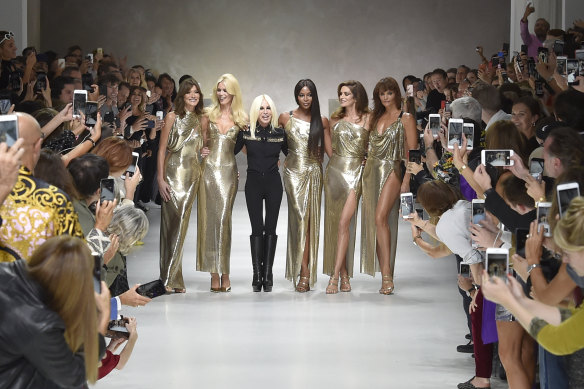
Donatella Versace with supermodels (left to right), Carla Bruni, Claudia Schiffer, Naomi Campbell, Cindy Crawford, Helena Christensen, walk the runway at the Versace Spring Summer 2018 fashion show during Milan Fashion Week.Credit: Getty
Donatella, untrained and for a long time unserious, was never meant to become one of the most famous fashion designers in the world. In her seventh decade, she finds herself fronting a company that’s bigger than ever since Capri Holdings (the fashion group founded by Michael Kors which also owns Jimmy Choo) bought it five years ago for just over $US2 billion. All this has made her an unexpected role model.
She baulks at that suggestion. “If people like me now it’s just because I’ve been around such a long time.” She’s underselling her achievement: there’s something impressive about the way she’s survived and ultimately thrived. “I have to pinch myself sometimes,” she says of how things have played out.
There was a time, specifically the mid-noughties, when the Versace business looked precarious. Her brother Gianni’s “more is more” philosophy of piling baroque patterns on to animal prints, embellishing everything with gold Medusa heads and working in some bondage straps for good measure was always divisive. But his genius for tailoring and pushing creative and technical boundaries earned him unanimous respect. He was the first fashion designer to be given a solo show at London’s Victoria & Albert Museum, in 1985; he designed costumes for La Scala, the Royal Opera House and the San Francisco Opera. Even his arch rival Giorgio Armani described him as “a great creator”.
After Gianni’s death in 1997, Donatella stepped into the breach. At her best, she brought a more wearable, less theatrical sensibility to the house that could nevertheless produce major fashion magic. The plunging jungle-print dress Jennifer Lopez wore to the Grammys in 2000 – so famous that Google created Google Image Search to cope with the demand – was designed under Donatella’s watch.
“The amazing thing about that dress is that it was all quite unpremeditated compared with how planned things are now,” says Donatella. “She just liked it and wore it. I don’t think she thought too much about the consequences.”
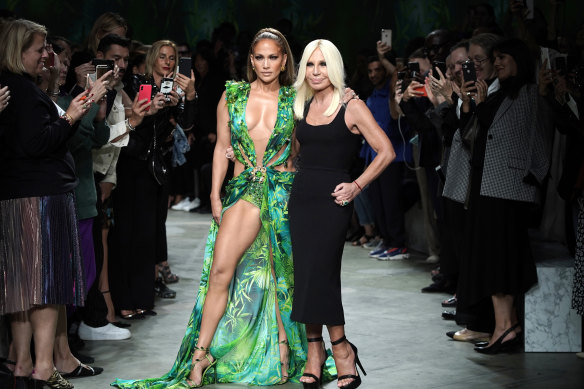
Jennifer Lopez and Donatella Versace walk the runway at the Versace show during the Milan Fashion Week Spring/Summer 2020.Credit: Getty
The J.Lo dress was a highlight, but Donatella’s overall creative output was erratic. By the poorly received 2005 spring/summer show in Milan – described by one critic as “a defiant limp” – the brand’s revenue had fallen by €300 million since Gianni’s death. All of which makes the turnaround since remarkable: vintage pieces hotly pursued by Gen Z and new collections worn by millennial talent (and Michelle Obama on her book tour) as well as by Hollywood royalty such as Jane Fonda, who still orders pieces in her 80s.
“People rightly talk about Gianni’s talent,” says Fflur Roberts, the head of luxury goods at Euromonitor International, a market research company. “But there’s a reason Capri Holdings paid such a high price and has injected so much energy into Versace, and that’s Donatella. She’s the heart of it. She knows the culture of that house inside out.”
In March, with its old swagger back and then some, the Versace brand took its show to Los Angeles, two days before the Oscars. It was al fresco, with no plan B, and at the last moment the team had to bring the event forward by 24 hours to avoid torrential rain on their parade. Rather than cancelling, more celebrities asked to be added to the guest list. By the time 40 seamstresses had been flown over from Milan and the production costs and after-parties were paid for, the event was reputed to have cost $12 million.
As the sun set into the Hollywood Hills, Donatella unleashed some of her best work in front of an audience that included old- and new-guard celebrities: Cher, Elton John, Demi Moore, Dua Lipa, Channing Tatum, Miley Cyrus, Lily James, Anne Hathaway, Pamela Anderson … At the Oscars themselves, Lady Gaga wore the boned black dress Gigi Hadid had modelled on the catwalk, while Lily James wore a ravishing soft pink-feathered slip dress to Vanity Fair’s after-party.
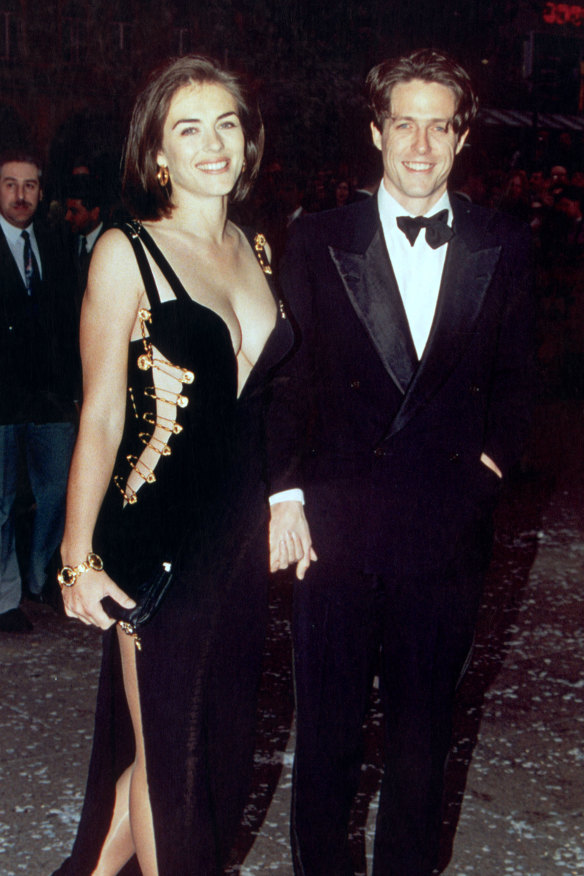
Elizabeth Hurley in ‘that’ dress attending the premiere of Hugh Grant’s film, Four Weddings and a Funeral in London, 1994.Credit: Getty
Versace’s relationship with James – they began working together in 2022, in a campaign for the brand where she was transformed from English rose to gothic vamp courtesy of a jet-black fringe – demonstrates the new direction in which Donatella has steered the brand, broadening its appeal beyond the obvious va-va-voom starlets.
Transformations are what Donatella lives for. “Like any celebrity, Lily has her insecurities,” she says. “The red-carpet experience is like being naked. The whole world is looking and you can’t hide behind a character.”
This is where Donatella’s beloved corsetry comes into play. But how do you make it comfortable? “Comfort is a very overrated word,” she deadpans. Except she’s not entirely joking. “In some contexts, comfort is not as important as confidence. Sometimes people put on the dress and say they can’t breathe. I tell them to get used to it. Within seconds, they do.”
In May, two months after the LA show, Donatella, encased in corsetry and looking quite unlike any other 68-year-old, was on the red carpet at the Met Gala celebrating Karl Lagerfeld. She’d designed Anne Hathaway’s outfit – a tongue-in-cheek Versace take on Chanel that saw Liz Hurley’s 1994 safety-pin dress redone in vanilla tweed.
A few months ago, the Versace show was on the road again, debuting a Vacanza Collection “co-designed” with singer Dua Lipa at the Cannes Film Festival. To be a big player these days, a brand must pull one off these “activations” every couple of months.
It sounds exhausting. Donatella keeps fit by exercising (a lot of Pilates), eating mainly vegetables, fish and, occasionally, brown rice, and on Fridays working from her home on Lake Como. She has finally given up smoking. There’s an unlit banana-flavoured e-cigarette in her hand, which is better than the two packets of Marlboros she used to get through daily. “My doctor said, ‘If you don’t quit, you won’t see me again.’ ” So she did, overnight.
“The red-carpet experience is like being naked. The whole world is looking and you can’t hide behind a character.”
DONATELLA VERSACE
For the first 42 years of her life Donatella had a fairly enviable time, running around as the indulged sister of Gianni. There’s another brother, Santo, the eldest of the trio, who for years oversaw the business. There was also a sister, Tina, older than all of them, who died aged 12 from a tetanus infection.
Antonio Versace, the patriarch, came from affluent stock. Francesca, his wife, was a self-made couturier who was determined her children would do well. “I had a perfectly happy childhood, but we were very disciplined as a family,” says Donatella.
She and Gianni, especially, adored one another, but it was, at times, complicated. Donatella and her then-husband Paul Beck, a Versace model and the father of her two children (Daniel, now 33, and Allegra) were so close to Gianni and his boyfriend, Antonio D’Amico, they lived in each other’s admittedly capacious pockets. By their own admission, the family dynamic could get highly operatic.
The Versaces were not exactly publicity-averse. “Gianni was the first to dress celebrities,” Donatella tells me. Armani would probably dispute that – he led the Hollywood invasion when he dressed Richard Gere for American Gigolo in 1980, when the Versace company was barely two years old. But while Armani preferred A-list actors, Versace loved them all. Prince, Elton, George Michael, Sting and Trudie (he designed their wedding outfits) … Gianni and Donatella were unashamedly star-struck, endlessly hosting them at their increasingly lavish homes.
It was a dream existence for Donatella, who could play at being designer (Gianni let her have Versus, a spin-off line launched in 1989), socialite and muse. He took her advice seriously, listening to her instructions to go shorter, tighter, more, more, more – just as she’d once listened to him telling her to go blonder and browner.
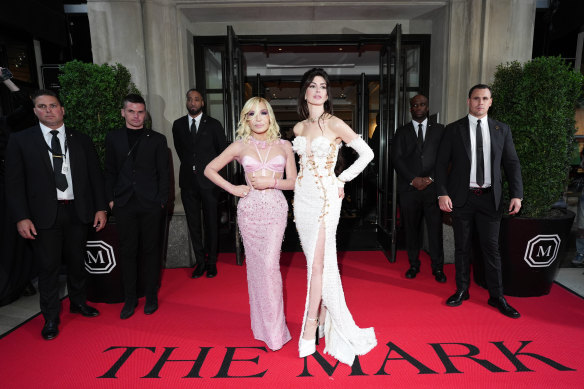
Donatella Versace and Anne Hathaway for the 2023 Met Gala in New York City. Credit: Getty
Christopher Kane, the British designer who worked with Donatella in 2009 when she relaunched Versus, says her impact was more profound than she’s given credit for. “Gianni was one of fashion’s greats, and together they were part of something so progressive and new in fashion history. It was Donatella who challenged society’s perception of how women could dress and feel. Even now, there isn’t one fashion student or studio who hasn’t pinned them to a wall.”
Better still, she had influence without the responsibility of running a company. Also, in those days, without the mob on social media, being famous was arguably a lot more fun.
Until it wasn’t. Gianni was murdered at the family’s holiday home in Miami in 1997 and Donatella, along with Allegra, then 11, inherited a major chunk of the company. Donatella had to step up and become the public face of the brand at a time when she felt “destroyed” inside. The destruction was partly self-inflicted – drink, drugs. Allegra was ill with anorexia. It was a huge amount to deal with.
She grieved for years while trying to keep afloat a company where the good times were never supposed to stop – all the while under fire from the tabloid press. She understands how Madonna, whom she recently outfitted in a black tuxedo, must be feeling. “She’s been very badly attacked on social media. I think she’s probably feeling quite down.”
Does she think there’s more ageism and misogyny around, as Madonna has claimed? “I don’t like to give it too much thought. If people are misogynist towards me, frankly that’s their problem. I decided a long time ago it’s not going to change the way I behave.”
Outwardly, Donatella’s not making any obvious concessions to age. She looks after her skin more carefully and no longer tans the way she did. “When I realised how the sun was destroying my skin, I stopped.” Also, the fillers have gone. “I don’t like that look any more, so I had them removed. I don’t think spending a lot of time thinking about how old you are is helpful. I think it’s more important to be kind – to others and to yourself.”
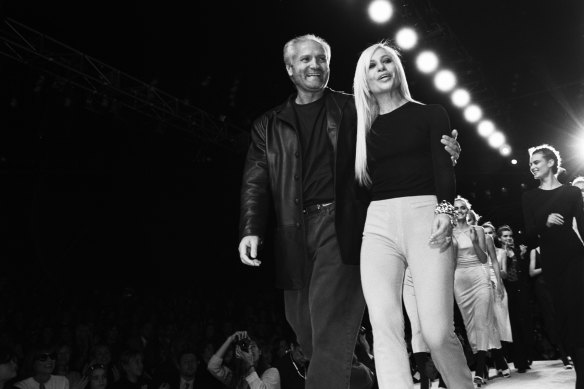
Donatella and her brother Gianni on the runway after a Versace fashion show in New York, 1996. Credit: Getty
She’s naturally drawn to outsiders, donating to AIDS charities and lending support to LGBTQ+ communities. Plenty see her as a shoulder to cry on. I start to ask her something about empathy… “I try to forgive myself,” she says, suddenly. “But some things I can’t forgive myself for.” Her voice falters. “I still have so much guilt from those early times, after Gianni died.”
I assume she means guilt for initially letting the company slide but, even after all these years, her grief is more visceral than that. “Gianni wanted us all to get to Miami a day earlier than we did – Paul, me and the children. But for some reason, I don’t remember exactly what, we didn’t. We were in Rome and I said, ‘What’s the rush?’
“Gianni wanted us all to get to Miami a day earlier than we did – Paul, me and the children. But for some reason, I don’t remember exactly what, we didn’t.”
DONATELLA VERSACE
“If we’d [gone sooner], there would have been more security around the house, because of the children …” She brushes tears from her eyes. For almost 30 years she’s lived with the belief that if they’d arrived in Miami earlier, Andrew Cunanan wouldn’t have got close enough to her brother to shoot him.
If the house of Versace has not fallen foul of political correctness in recent times, unlike some of its Italian peers, that’s partly because Donatella and Gianni Versace were always inclusive. Donatella has made a point of working with young talent and she has a shrewd eye. After she relaunched Versus, she collaborated not just with Kane but JW Anderson, another UK standout who now runs Loewe, then Anthony Vaccarello, who went on to head Saint Laurent. “She has this rock-star vibe but she’s very down-to-earth and funny to everyone,” says Kane.
“I think if you listen to your team, you’re more likely to get it right,” says Donatella. “But still, you have to be very careful what you say now because things so quickly get distorted.”
I ask what advice she’d give to younger women today. “To step back from technology sometimes and not chase likes or followers, because getting lost in things that are just for now can so quickly get out of control.
“But why should young people listen to me?” she says, laughing. “My daughter certainly doesn’t.”
Make the most of your health, relationships, fitness and nutrition with our Live Well newsletter. Get it in your inbox every Monday.